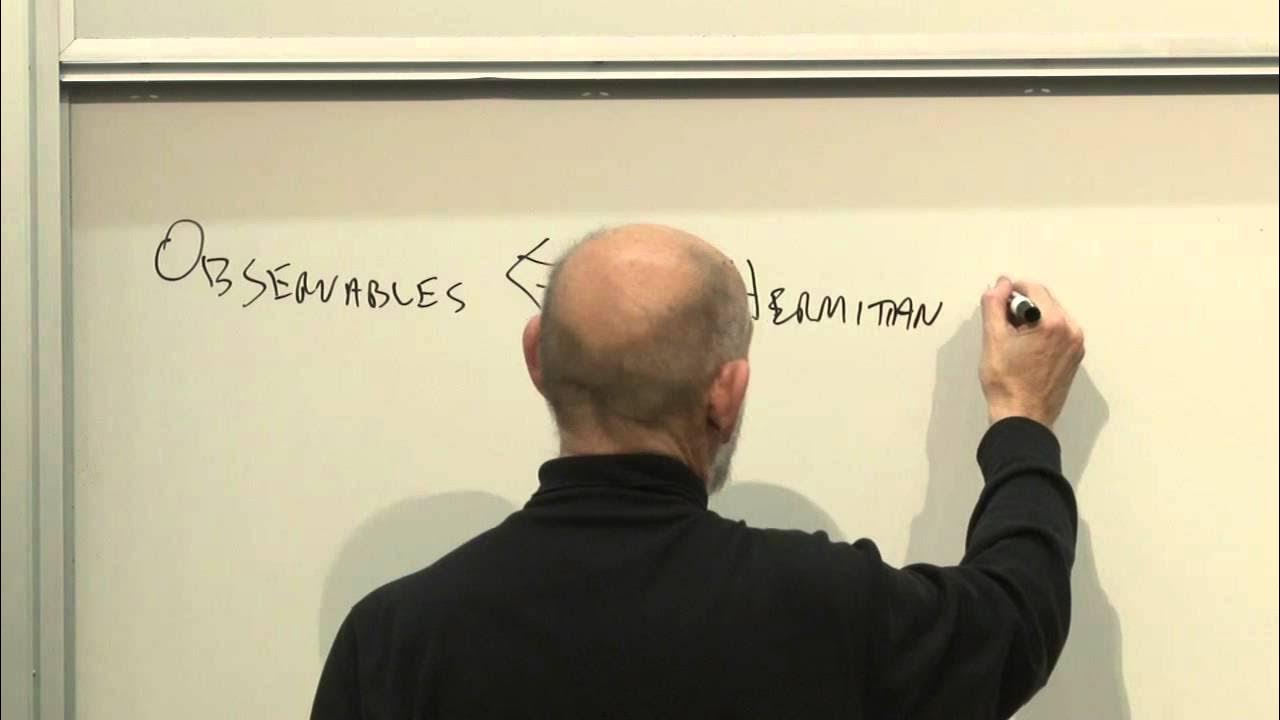Ch 7: How are observables operators? | Maths of Quantum Mechanics
TLDRThis script delves into the representation of physical quantities in quantum mechanics through linear operators on Hilbert space. It explains how observables like position, momentum, and energy are associated with these operators, and introduces the concept of eigenvalues and eigenvectors to describe measurable values and their corresponding quantum states. The script emphasizes the physical intuition behind the requirement for observables to have real eigenvalues and an orthonormal eigenbasis, setting the stage for the Born rule's discussion in a future episode.
Takeaways
- 🌟 In quantum mechanics, physical quantities are represented by linear operators on Hilbert space, which are abstract maps preserving the space's linear structure.
- 📐 The term 'observable' is used to refer to any physical quantity that can be measured, such as position, momentum, energy, and angular momentum.
- 🔍 To determine the possible values of an observable, one looks at the eigenvalues of the corresponding operator, and the corresponding states are found through the eigenvectors.
- 🌀 Eigenvectors associated with distinct eigenvalues represent definite states, or eigenstates, which are certain to have those specific values for the observable.
- 📈 Observables in quantum mechanics must have real eigenvalues because physical quantities are inherently real and measurable.
- 🔢 The eigenstates of an observable must span the entire vector space, meaning any quantum state can be expressed as a linear combination of these eigenstates.
- 📍 Eigenstates must be mutually orthogonal (perpendicular) to accurately represent definite states without ambiguity.
- 🔑 An observable's eigenstates form an orthonormal basis for the Hilbert space, which is derived from physical intuition rather than assumed properties.
- 🤔 The script hints at the upcoming derivation of the Born rule in quantum mechanics, which will connect the mathematical model of quantum physics and address probability calculation.
- 🎓 Understanding the properties of observables and their representation through operators is fundamental to the mathematical framework of quantum mechanics.
Q & A
How are particles represented in Hilbert space?
-Particles are represented by kets in Hilbert space, which are vectors that describe the quantum state of the particle.
What is the role of linear operators in quantum mechanics?
-Linear operators represent physical quantities in quantum mechanics. They are maps on a vector space that preserve the linear structure, meaning they maintain the properties of addition and scalar multiplication.
What is an observable in quantum mechanics?
-An observable is any physical quantity that can be measured from a particle, such as position, momentum, energy, or angular momentum.
How can we determine the possible values for a physical observable?
-The possible values for a physical observable, which are the eigenvalues, can be determined by finding the eigenvalues of the corresponding linear operator.
What are eigenstates, and how do they relate to observables?
-Eigenstates are the eigenvectors corresponding to specific eigenvalues of an observable's linear operator. They represent definite states that are 100% certain to have the observable's value.
Why do observables need to have real eigenvalues?
-Observables need to have real eigenvalues because physical quantities are inherently real, and it doesn't make sense for a physical quantity to have a complex value.
How do the eigenstates of an observable relate to the entire vector space?
-The eigenstates of an observable must span the entire vector space, meaning that any quantum state can be written as a linear combination of these eigenstates.
Why must the eigenstates of an observable be mutually orthogonal?
-Eigenstates must be mutually orthogonal because if they were not, it would imply that a definite state could have a superposition of other observable values, which contradicts the definition of a definite state.
What is the significance of an orthonormal eigenbasis in quantum mechanics?
-An orthonormal eigenbasis, formed by the eigenstates of an observable, is significant because it allows any quantum state to be represented as a linear combination of these eigenstates, which is essential for calculating probabilities and making measurements.
How does the Born rule relate to the eigenstates and eigenvalues of an observable?
-The Born rule is used to calculate the probability of obtaining a particular eigenvalue when measuring an observable. It will be derived in the next episode and will connect the mathematical model of quantum physics.
Why do we assume observables to be Hermitian operators in quantum mechanics?
-Observables are assumed to be Hermitian operators because this assumption leads to the properties we derived from physical intuition, such as having real eigenvalues and an orthonormal eigenbasis. In the next chapter, it will be shown that these properties imply that observables are Hermitian.
Outlines
🌟 Quantum Mechanics: Observables and Operators
This paragraph introduces the concept of physical observables in quantum mechanics, such as position, momentum, and energy, and how they are represented by linear operators on Hilbert space. It explains the shift in language to use 'observable' for any measurable physical quantity and revisits the formal definition of a linear operator. The paragraph emphasizes that while a linear operator is an abstract map, matrices represent these operators in specific bases. It then delves into the quantum mechanics framework, suggesting that physical observables are represented by linear operators and that the possible measurement values are associated with the eigenvalues of these operators. The concept of eigenstates as definite states with certain values for an observable is introduced, and the framework for representing observables in quantum mechanics is established.
🔍 Eigenvalues, Eigenvectors, and Quantum States
This paragraph explores the relationship between eigenvalues, eigenvectors, and quantum states, focusing on how they relate to the measurement of physical observables. It discusses the properties that physical observables should have, such as having real eigenvalues and their eigenstates spanning the entire vector space. The paragraph argues that any quantum state can be expressed as a linear combination of an observable's eigenstates. It also introduces the concept that eigenstates must be mutually orthogonal, as non-orthogonal states would contradict the definition of definite states. The paragraph concludes by showing that an observable's eigenstates form an orthonormal eigenbasis, providing a physical intuition-based proof for this property.
🚀 Conclusion and Future Discussion
The final paragraph wraps up the discussion on observables and operators, and teases future topics. It summarizes the key points made in the previous paragraphs, reaffirming that all physical observables are represented by linear operators with orthonormal eigenbases, and that the eigenvalues are real. The paragraph sets the stage for the next episode, where the Born rule will be derived, connecting the mathematical model of quantum physics and addressing the calculation of probabilities associated with each eigenvalue measurement.
Mindmap
Keywords
💡Hilbert space
💡Kets
💡Observables
💡Linear operators
💡Eigenvalues and eigenvectors
💡Eigenstates
💡Superposition
💡Born rule
💡Orthonormal eigenbasis
💡Hermitian operators
💡Physical intuition
Highlights
The episode focuses on the representation of physical quantities in quantum mechanics.
Physical quantities are represented by linear operators on Hilbert space.
Observables are any physical quantity that can be measured, such as position, momentum, energy, and angular momentum.
A linear operator is a map on a vector space that preserves the space's linear structure.
Eigenvalues and eigenvectors play a crucial role in representing possible measured values and their corresponding states.
Eigenvectors associated with specific eigenvalues are called eigenstates, representing definite states with certain values for an observable.
Quantum states can be represented as a superposition of all possible outcomes of a measurement, which are the eigenstates of an observable.
Observables must have real eigenvalues because physical quantities are inherently real.
Eigenstates of an observable must span the entire vector space, meaning any quantum state can be written as a linear combination of eigenstates.
Eigenstates must be mutually orthogonal, ensuring that definite states are not superpositions of other states.
An observable's eigenstates form an orthonormal eigenbasis, spanning the entire space and being mutually orthogonal.
Physical intuition leads to the conclusion that observables are hermitian operators, which is usually assumed in quantum mechanics.
The Born rule will be discussed in the next episode, connecting the mathematical model of quantum physics.
The framework for representing observables in quantum mechanics is based on the properties of linear operators and their eigenstates.
The episode provides a fundamental understanding of how observables are represented and how they relate to quantum states.
The mathematical model of quantum physics is built upon the properties of observables and their corresponding eigenstates.
The discussion on eigenstates and eigenvalues provides a deeper insight into the nature of physical observables in quantum mechanics.
Transcripts
Browse More Related Video

Ch 9: What are Hermitian operators? | Maths of Quantum Mechanics

Lecture 2 | Quantum Entanglements, Part 1 (Stanford)

Ch 10: What's the commutator and the uncertainty principle? | Maths of Quantum Mechanics

Lecture 3 | Quantum Entanglements, Part 1 (Stanford)

Lecture 3 | The Theoretical Minimum

Advanced Quantum Mechanics Lecture 1
5.0 / 5 (0 votes)
Thanks for rating: